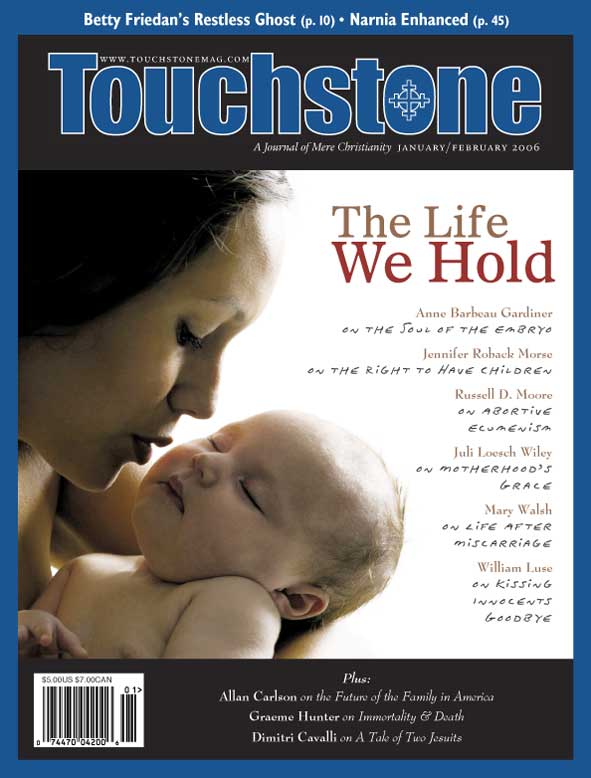A Stone for Shmuel
The Killing We Live With & the Hell We Enjoy
by William Luse
My twenty-year-old daughter sat at the other end of the couch from me one night a couple of years ago, reading a magazine while I watched TV. She glanced up every now and then to capture what was happening on the tube, but by and large was quite absorbed in her reading, which usually amounts to a lot of page flipping, so that I had gotten into the habit of asking, “Do you ever read anything or just look at the pictures?”
But at the moment I paid her little attention, so absorbed was I by the news of the Palestinian murder-suicide bombing of a bus in Jerusalem. Apparently there were an unusual number of child victims. I saw one infant lying motionless in the street, being worked on by guys with funny beards and black caps, ultra-orthodox medical personnel I suppose. Then a girl came on the screen, seven or eight years old, wearing a red and black striped jumper over a long-sleeved white shirt, reminding me of the Catholic school uniforms my girls used to wear. She stood erect, adorable, and seemed not in peril of dying, but there was a lot of blood running down her face.
The camera moved to a hospital, where six-month-old Shoshana Nathanzon lay wired, taped, cut up, one arm in a cast, but alive. The youngest victim was Shmuel Tabenfeld, five months along in this life. He and his mother, Goldie, were from New York, and she died with him. I thought you might like to say good-bye to Shmuel, whose picture is above.
I sat there trying to think of a name for people who think it’s all right to blow babies to bits. We humans often think that if we can hang a name on something, we can open it up, understand it, reveal the mystery. We can’t, and nothing came to me. Maybe you could think of one if shown a picture of the guy who did it.
I have the picture, but don’t want to give a child-killer the honor. Let’s just say that he looks so . . . normal, so swarthy middle-American, as he stands there dressed in slacks and a sport shirt. I like the delightful children’s mural in the background. The two kids propped on each arm are his own, for whom he was just trying to set a good example by exterminating someone else’s.
He has a name but I hope never to remember it or ever to hear it again. Besides, it’s sure to be long enshrined within the Palestinian Pantheon of Martyrs Who Have Gone to Heaven in a Thousand Handbaskets. I wonder if he believed in the seventy-odd virgins reward, like Mohammed Atta, who at this moment is finding that the reward for mass murder is not at all what he expected.
Never Seen the Ocean
“Oh my God!” my daughter cried. “Awful, isn’t it?” I responded. But she was not looking at the television. I could tell by the magazine’s thickness that it was one of those women’s things.
“Listen to this,” she said, and started reading from an article entitled, “Are You Ready to Really Understand Abortion?” It was a puff piece. One of the great rewards of my life has been this child’s militancy on behalf of the unborn. She was especially upset that one of the protagonists in the piece was a 32-year-old dental hygienist named Bernadette, who had come to a clinic for an abortion.
Bernadette was divorced, had lost custody of her twin girls to her ex-husband, but was now engaged to a new guy, Charley. She liked Charley. “He listens to me.” Bernadette had been on the Pill but gotten pregnant anyway. On her chart she had checked the box that says the decision to have an abortion was a difficult one. Why? “Because I remember what it was like to be pregnant and to have babies.”
But she is certain about not going ahead with this one. She got married in her senior year of high school and had children in short order. “I want to see things,” Bernadette says, explaining that she and Charley are hoping to go to Florida on vacation. Looking excited and embarrassed at the same time, she says, “I’m 32, and I’ve never seen the ocean.”
“Take the kid to the beach!” yells Bernadette, my Bernadette. She read a few more passages. “What is wrong with these people?”
I told her that she ought to write a letter to the editor, informing said personage that his or her refusal to tell the whole truth has resulted in her refusal ever to purchase the magazine again. Goodbye. She nodded in a subdued way, apprehending the logic but not its need to end in a promise. I think her mind was looking for wiggle room.
Teenagers and young women want so to admire these secular icons of womanly beauty, in spite of the reality that often breaks in. They want to know what clothes are fashionable among the glitterati, pass an opinion on their various hairstyles, gaze at their jewelry, consider their makeup, envy their ostensible talent and consequent claim to fame, size up their men, scrutinize their moribund love lives, and read their vacuous, clichéd thoughts on the most important matters. My kid seems to have good sense, and is adept, I must trust, at filtering out the dross. Still, there’s the fascination.
“You’re as beautiful as any of them,” I’ve often said, something you cannot say to most girls and expect to be believed. But even from this one, whom you would expect to believe it, I get the response, “You always say that.” Of course, I meant it in a sense far more than the physical, but women doubt themselves, even the beautiful ones. It’s a mystery.
The Gang
After she went to bed, I picked up the magazine. Glamour. A bronze beauty named Beyoncé graced the cover. I don’t know who she is, but readers seemed to need no introduction other than the words “gutsy, grounded, inspiring.” The feature story was titled “Your A to Z Guide to MEN! Their bodies, their obsessions, and what they want from you.” The rest of the articles were about makeup, fashion, Your Body, and the socially redeeming stuff about breast cancer, fitness, and health.
I found the abortion article and started scanning. It concerned a loosely connected group of baby-killing, abortion-providing clinics known collectively as the November Gang, formed during that fateful November of 1989 when, feeling “beleaguered, besieged, exhausted and frightened” by “constant threats” and the “700 plus protestors of Operation Rescue” blocking access to their doors on a daily basis, these clinics felt their very survival to be at stake.
Representatives from the clinics got together, whined their support for each other, and after a couple of years came up with a new idea. They started “to ask different questions. . . . Why were some patients feeling confused after their abortions? How could [we] help [them] . . . heal?” Henceforth, they became the November Gang, a kinder, gentler sort of baby-killing clinic.
For example, at the Allegheny Reproductive Health Center in Pittsburgh, the walls of the “inner waiting room” are lined with pink paper hearts on which the mothers of aborted babies have inscribed messages. One reads: “This has got to be the hardest decision I’ve ever had to make. . . . I love you even though I know I can’t keep you. . . . I know your spirit is in a better place. . . . You will always be a part of me even though you are not here with me. All my love, the Mom you’ll never meet but I’m sure you know who I am.”
Another, in block letters: “Even if it doesn’t feel right doesn’t mean it’s wrong.” And another: “To my little Angel, Please understand that you are better off in the hands of God than mine at this moment. . . . You are and forever will be beautiful and pure. . . . You will always be my baby. I will see you in heaven, sweetheart. I love you.”
Not to coach the reader too closely, but what we have here is the religious impulse in the devil’s service. These ladies have re-ordered their reason, to much rejoicing in hell. The author of the piece claims that he (or she—first name Daryl) “never expected to find so much raw emotion in the waiting room of an abortion clinic.” As opposed to what? Cooked emotion? If Daryl really wanted to see something raw, he/she might enter the door marked Procedure Room and take a gander at what gets dumped in the pan. But of course he/she never does.
Whatever They Call It
The folks in the November Gang clinics are taking a new approach in their attempt to connect with clients. For example, they try “echoing” the clients’ language. Words like “killing,” “baby,” and “God” are not encouraged, but neither are they discouraged. “‘I call it whatever the patient calls it,’ says Amy Hagstrom, the owner of the Whole Women’s Health Clinic in Austin, Texas,” eschewing the “choice” rhetoric of “the movement.”
November Gangers try to get the “patients” to open up a little by feeding them loaded softballs, questions with the justification built in, such as, “Do you feel it’s OK to kill a fetus for your own life?” Or: “Does being a good mother sometimes mean acknowledging that I can’t be a mother right now?” Or: “Can you see abortion as a loving act toward your children and yourself?” Presented in this way, says Debi Jackson, executive director of Cincinnati Women’s Services, many of their clients “actually think about it and they’re like, ‘Yeah, that’s what I’m doing. I do love this child but I can’t have it right now.’”
There, wasn’t that easy? According to Jackson, being witness to such enlightenment “is one of the most rewarding aspects of clinic work. . . . It’s wonderful to see someone, perhaps for the first time, making a choice based on love for herself and belief in herself and not simply letting life happen to her.” And we all love conversion stories.
But if any of these questions should reveal that “a patient equates ending her pregnancy with murdering a living person,” the Gangbangers tell her to take more time to think about it. “Murder is illegal,” says Renee Chelian, executive director of three—count them, three—Northland Family Planning Centers in Detroit. “If someone is asking us to participate in murder, I can’t feel good about the work I do and neither can the staff.” I think this was the part that most outraged my daughter, that a thing is not what it is, but what you call it.
Another Gang practice, as at the clinic in Pittsburgh, is to “end every counseling session by offering patients a colorful stone they can take home with them; women can imbue it with whatever meaning they choose.” I’ve heard of trying to wring blood from a stone, but I never quite got this one. It reminds me of the Pet Rock craze of the seventies, wherein (I’m supposing, never having owned one) we pretended that a thing inanimate was alive.
I don’t know what the women do with the stones—murmur to them, rock them to sleep?—but the clinic gets calls from prospective purchasers of their product asking, “Is this the place that gives out the stones?”
Medicating Answers
Religious expression is not forbidden at these clinics. In fact, such a bizarre mix of church and state-sanctioned execution this reader has seldom seen. Claire Keyes, director of the Pittsburgh clinic, “allows” women who request it “to pray over their fetuses, and even perform ad hoc ‘baptisms.’ For the most part, that means sprinkling water over a surgical pan that contains fetal tissue, which can be as small as a grain of rice.” Or as big as what? Unless a grain of wheat. . . .
And then there’s Tanya, a 22-year-old mother of two “who works in retail” and who has indicated on her chart that she has religious reservations. “I’m killing my baby,” she says. “Will God forgive me?” It seems to me she’s asking the wrong person, unless she knows what she wants to hear. And Keyes responds with a question of her own, pre-loaded with self-medication: “Do you think there are any things God considers completely unforgivable?” Tanya grabs onto this cliffside branch for dear life, for there can be only one answer.
Or take the case of Frances, age 45, who wrote on her pink heart: “When I finally confessed my abortion—after 25 years—I dreaded what kind of penance the priest would give me. He said, ‘I want you to say one Our Father and one Hail Mary. Then I want you to go home and make a list of the good things you’ve also done in all those years. Until you see the past wasn’t all bad, you can’t move into the future.’ I did, and it made all the difference in the world.”
And another burden has been lifted, another spirit, caged for so long, has taken wing. This transformation happens most often in those Catholic parishes where a remorseful conscience is not essential to the Sacrament, just dread of penance.
As I was laying this magazine aside, it slipped to the floor and fell open to another article, “Be Yourself in Bed,” in which we are informed by a lady expert who has written her very own book on the subject that “women value living life on their own terms, not following a script based on religion, family, or even feminism. It leads to a more authentic, honest life.”
She cites the case of 26-year-old Chester (a girl) who was raised Baptist and lost her virginity at 19, which event felt sinful at the time. But Chester has overcome, and can now write in a “sexual mission statement” that she believes in—along with candles and flowers and he-men with hearts—zero shame. “Many women,” says the lady expert who has written her very own book by virtue of which she is an expert, “have to overcome the sexual guilt that can come from a religious upbringing. Examining religion is now a rite of passage for women, who understand that heeding their own conscience is what’s really important.”
“Little by little, man by man, Chester has identified what makes her feel good in bed.” I guess examining her religion made Chester realize that she was destined to become a slut for God, unless she has chucked the religion, which seems more likely. I expect she’ll be visiting the November Gang before long.
At Home on Earth
There’s probably a name for the pattern I’m seeing here—in the disconnect between an act and its effects, between a desire for justice and a justification, between a reality and the appearance we give it—but I don’t know what it is. I’m afraid that if I name it, I’ll not have explained it but rather given it an imprimatur, a murderous new twist, perhaps, on an old theme: God is my co-pilot. From Palestine to Pittsburgh, that seems to be how it works. I wonder what that murder-suicide bomber with a wife and two cute kids called himself. Others call him a holy martyr.
All I know is that hell has a home on earth. If we can just come up with the right perspective, find the right name for it, call it by what we want it to be rather than what it is, we can live there quite comfortably. If we “examine” our religion long and hard enough, we can lose it or remake it in our own image.
It comes to the same thing. God’s way is my way, and if there be no God, my way is the only way. I’m sure the bomber loved his family and his religion, and was as sincere as that woman who wrote to her dead baby on the pink paper heart, “I will see you in heaven, sweetheart.” But it seems to me a new kind of love, love as redefined by William Blake’s Pebble:
Love seeketh only Self to please,
To bind another to Its delight,
Joys in another’s loss of ease,
And builds a Hell in Heaven’s despite.
It is love as not love, as a phantasm of the mind, not so much renamed (for its very sound is the most powerful on earth) as re-imagined through the prism of the almighty Self, and great parts of the earth now bear witness to the claim of Milton’s lost archangel, that “the mind is its own place, and in itself can make a Heaven of Hell, or a Hell of Heaven.” It’s a claim as old as the assurance offered our first parents, that if they just listened to their own counsels, their eyes would be opened, and they would not “surely die.”
You’d think by now we could face the facts, the reality, seeing as how we keep on dying. Maybe we don’t face it because, in the wondrous inversion peculiar to our times, we no longer die to ourselves but are in love with them; no longer die to love but are in love with death. I don’t understand it, can’t explain it, and I’m sure as hell not going to give it a name, for the one reality I’d like not to face is the one requiring us to give the devil his due.
William Luse is an adjunct professor of English at Valencia Community College in Orlando, Florida, and host of the Catholic website Apologia.
subscription options
Order
Print/Online Subscription

Get six issues (one year) of Touchstone PLUS full online access including pdf downloads for only $39.95. That's only $3.34 per month!
Order
Online Only
Subscription

Get a one-year full-access subscription to the Touchstone online archives for only $19.95. That's only $1.66 per month!
bulk subscriptions
Order Touchstone subscriptions in bulk and save $10 per sub! Each subscription includes 6 issues of Touchstone plus full online access to touchstonemag.com—including archives, videos, and pdf downloads of recent issues for only $29.95 each! Great for churches or study groups.
Transactions will be processed on a secure server.
more from the online archives
calling all readers
Please Donate
"There are magazines worth reading but few worth saving . . . Touchstone is just such a magazine."
—Alice von Hildebrand
"Here we do not concede one square millimeter of territory to falsehood, folly, contemporary sentimentality, or fashion. We speak the truth, and let God be our judge. . . . Touchstone is the one committedly Christian conservative journal."
—Anthony Esolen, Touchstone senior editor









